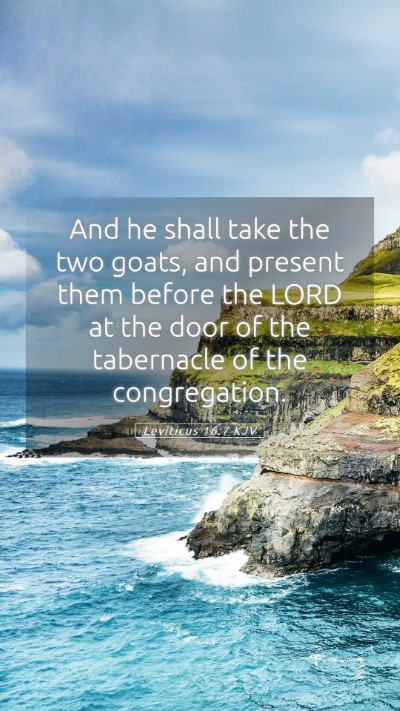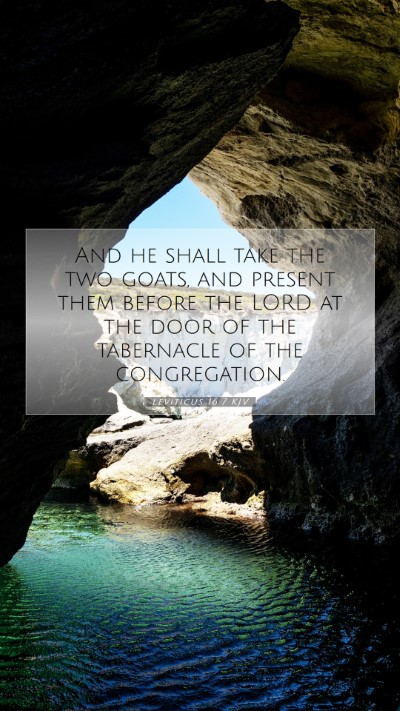Bible Verse Commentary: Leviticus 16:7
Verse: "And he shall take the two goats, and present them before the Lord at the door of the tabernacle of the congregation." - Leviticus 16:7
Overview: Leviticus 16:7 is a critical verse within the context of the Day of Atonement (Yom Kippur), where two goats are central to the Israelite’s atonement rituals. This verse highlights the symbolism of the goats in the sacrificial system, demonstrating the means of reconciliation between God and His people.
Meaning and Significance
This verse serves as a foundational element of understanding how God established a system for atonement in the Israelite community. The two goats represent different aspects of reconciliation and forgiveness. Let's explore a combined interpretation from several public domain commentaries:
Matthew Henry's Commentary Insights
Matthew Henry emphasizes the ritual nature of the Day of Atonement, illustrating the two goats as a representation of the dual aspects of atonement. One goat is chosen for the Lord and will be sacrificed, symbolizing atonement for sin. The second goat, known as the scapegoat, carries away the sins of the people into the wilderness, signifying the complete removal of sin from the community. Henry notes, "This is a notable type of Christ, who bears our sins and carries them away."
Albert Barnes Commentary Insights
Albert Barnes elaborates on the role of the high priest during this ceremony. He highlights the significance of the goats being presented before the Lord, indicating a divine selection process whereby the high priest casts lots to determine each goat's purpose. Barnes asserts that this ceremony showcases God's grace and mercy, as one goat is sacrificed while the other is released, emphasizing the comprehensive nature of atonement. "Casting lots illustrates God's sovereign choice in the process of atonement," he writes.
Adam Clarke's Commentary Insights
Adam Clarke discusses the symbolism of the goats further by explaining the cultural and spiritual implications of the ritual. He notes that the goats serve as a visible representation of Jesus Christ: "The goat for the Lord symbolizing his sacrificial death, while the scapegoat epitomizes freedom from sin." Clarke elaborates that the presentation of both goats signifies the acknowledgment of sin and the need for divine intervention. This illustrates the spiritual principles of confession and absolution that pervade the Scriptures.
Applications and Implications
The broader implications of Leviticus 16:7 can be applied to personal understanding of sin and atonement in contemporary Christian life:
- Awareness of Sin: Recognizing our need for atonement encourages believers to reflect on their own sins and seek genuine repentance.
- Understanding Sacrifice: The sacrifices made point towards the ultimate sacrifice of Christ, enriching the understanding of redemption.
- Restoration and Freedom: Symbolism of the scapegoat serves to remind believers of the freedom from sin provided through Christ.
Additional Cross References
- Hebrews 9:7: Discusses the role of the high priest and the sacrificial system.
- Leviticus 16:5: Describes the process of selecting the goats for the ceremony.
- Psalm 103:12: Expresses the removal of sins as far as the east is from the west.
Final Thoughts
The study of Leviticus 16:7 not only elucidates the ancient practice of atonement but also provides profound insights into the nature of sin and divine forgiveness. It serves as an essential scripture for personal Bible study and group discussions in Bible study groups, fostering a deeper understanding of Bible verse meanings and Bible verse interpretations.
Engaging with this verse in the context of online Bible study or through Bible study tools can lead to transformative insights into the ways God seeks to restore relationship with humanity.


